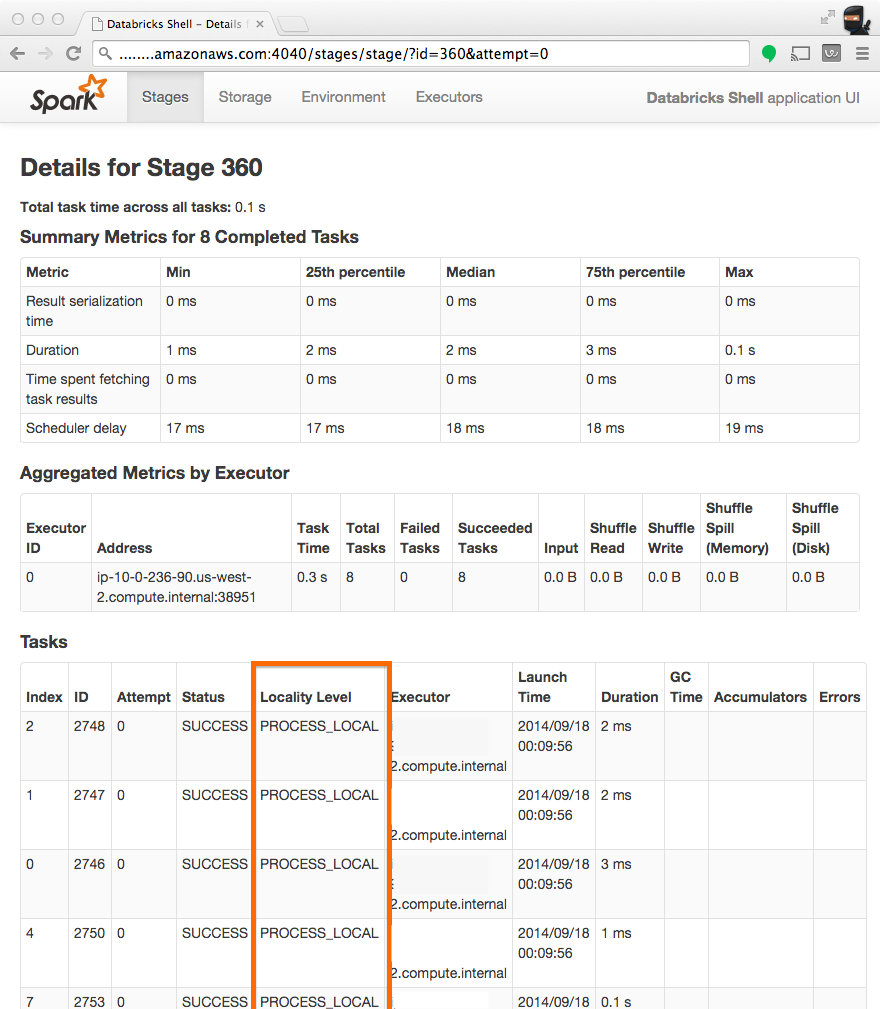问题导读
1.pendingTasksForExecutor是怎么来的,什么含义?
2.taskSetManager 的 locality levels是否包含 PROCESS_LOCAL?
3.sched.isExecutorAlive(_)干了什么?
4.taskSetManager 的 locality levels是否包含 NODE_LOCAL?
5.task的计算节点和task 的输入数据的节点位置关系包含哪些类型?

版本基于 spark-1.5.1 standalone 模式
在Spark Application Web UI的 Stages tag 上,我们可以看到这个的表格,描述的是某个 stage 的 tasks 的一些信息,其中 Locality Level 一栏的值可以有 PROCESS_LOCAL、NODE_LOCAL、NO_PREF、RACK_LOCAL、ANY 几个值。这篇文章将从这几个值入手,从源码角度分析 TaskSetManager 的 Locality Levels

这几个值在图中代表 task 的计算节点和 task 的输入数据的节点位置关系 - PROCESS_LOCAL: 数据在同一个 JVM 中,即同一个 executor 上。这是最佳数据 locality。
- NODE_LOCAL: 数据在同一个节点上。比如数据在同一个节点的另一个 executor上;或在 HDFS 上,恰好有 block 在同一个节点上。速度比 PROCESS_LOCAL 稍慢,因为数据需要在不同进程之间传递或从文件中读取
- NO_PREF: 数据从哪里访问都一样快,不需要位置优先
- RACK_LOCAL: 数据在同一机架的不同节点上。需要通过网络传输数据及文件 IO,比 NODE_LOCAL 慢
- ANY: 数据在非同一机架的网络上,速度最慢
我们在上图中看到的其实是结果,即某个 task 计算节点与其输入数据的位置关系,下面将要挖掘Spark 的调度系统如何产生这个结果,这一过程涉及 RDD、DAGScheduler、TaskScheduler,搞懂了这一过程也就基本搞懂了 Spark 的 PreferredLocations(位置优先策略)
RDD 的 PreferredLocations 我们知道,根据输入数据源的不同,RDD 可能具有不同的优先位置,通过 RDD 的以下方法可以返回指定 partition 的最优先位置: [mw_shl_code=scala,true]protected def getPreferredLocations(split: Partition): Seq[String]
[/mw_shl_code]
返回类型为 Seq[String],其实对应的是 Seq[TaskLocation],在返回前都会执行 TaskLocation#toString 方法。TaskLocation 是一个 trait,共有以三种实现,分别代表数据存储在不同的位置:
[mw_shl_code=scala,true]/**
* 代表数据存储在 executor 的内存中,也就是这个 partition 被 cache到内存了
*/
private [spark]
case class ExecutorCacheTaskLocation(override val host: String, executorId: String)
extends TaskLocation {
override def toString: String = s"${TaskLocation.executorLocationTag}${host}_$executorId"
}
/**
* 代表数据存储在 host 这个节点的磁盘上
*/
private [spark] case class HostTaskLocation(override val host: String) extends TaskLocation {
override def toString: String = host
}
/**
* 代表数据存储在 hdfs 上
*/
private [spark] case class HDFSCacheTaskLocation(override val host: String) extends TaskLocation {
override def toString: String = TaskLocation.inMemoryLocationTag + host
}[/mw_shl_code]
- ExecutorCacheTaskLocation: 代表 partition 数据已经被 cache 到内存,比如 KafkaRDD 会将 partitions 都 cache 到内存,其 toString 方法返回的格式如 executor_$host_$executorId
- HostTaskLocation:代表 partition 数据存储在某个节点的磁盘上(且不在 hdfs 上),其 toString 方法直接返回 host
- HDFSCacheTaskLocation:代表 partition 数据存储在 hdfs 上,比如从 hdfs 上加载而来的 HadoopRDD 的 partition,其 toString 方法返回的格式如 hdfs_cache_$host
这样,我们就知道不同的 RDD 会有不同的优先位置,并且存储在不同位置的优先位置的字符串的格式是不同的,这在之后 TaskSetManager 计算 tasks 的最优本地性起了关键作用。 DAGScheduler 生成 taskSetDAGScheduler 通过调用 submitStage 来提交一个 stage 对应的 tasks,submitStage 会调用submitMissingTasks,submitMissingTasks 会以下代码来确定每个需要计算的 task 的preferredLocations,这里调用到了 RDD#getPreferredLocs,getPreferredLocs返回的 partition 的优先位置,就是这个 partition 对应的 task 的优先位置 [mw_shl_code=scala,true]val taskIdToLocations = try {
stage match {
case s: ShuffleMapStage =>
partitionsToCompute.map { id => (id, getPreferredLocs(stage.rdd, id))}.toMap
case s: ResultStage =>
val job = s.resultOfJob.get
partitionsToCompute.map { id =>
val p = job.partitions(id)
(id, getPreferredLocs(stage.rdd, p))
}.toMap
}
} catch {
...
}[/mw_shl_code] 这段调用返回的 taskIdToLocations: Seq[ taskId -> Seq[hosts] ] 会在submitMissingTasks生成要提交给 TaskScheduler 调度的 taskSet: Seq[Task[_]]时用到,如下,注意看注释: [mw_shl_code=scala,true]val tasks: Seq[Task[_]] = try {
stage match {
case stage: ShuffleMapStage =>
partitionsToCompute.map { id =>
val locs = taskIdToLocations(id)
val part = stage.rdd.partitions(id)
//< 使用上述获得的 task 对应的优先位置,即 locs 来构造ShuffleMapTask
new ShuffleMapTask(stage.id, stage.latestInfo.attemptId,
taskBinary, part, locs, stage.internalAccumulators)
}
case stage: ResultStage =>
val job = stage.resultOfJob.get
partitionsToCompute.map { id =>
val p: Int = job.partitions(id)
val part = stage.rdd.partitions(p)
val locs = taskIdToLocations(id)
//< 使用上述获得的 task 对应的优先位置,即 locs 来构造ResultTask
new ResultTask(stage.id, stage.latestInfo.attemptId,
taskBinary, part, locs, id, stage.internalAccumulators)
}
}
} catch {
...
}[/mw_shl_code]
简而言之,在 DAGScheduler 为 stage 创建要提交给 TaskScheduler 调度执行的 taskSet 时,对于 taskSet 中的每一个 task,其优先位置与其对应的 partition 对应的优先位置一致
构造 TaskSetManager,确定 locality levels
在 DAGScheduler 向 TaskScheduler 提交了 taskSet 之后,TaskSchedulerImpl 会为每个 taskSet 创建一个 TaskSetManager 对象,该对象包含taskSet 所有 tasks,并管理这些 tasks 的执行,其中就包括计算 taskSetManager 中的 tasks 都有哪些locality levels,以便在调度和延迟调度 tasks 时发挥作用。
在构造 TaskSetManager 对象时,会调用var myLocalityLevels = computeValidLocalityLevels()来确定locality levels
[mw_shl_code=scala,true]private def computeValidLocalityLevels(): Array[TaskLocality.TaskLocality] = {
import TaskLocality.{PROCESS_LOCAL, NODE_LOCAL, NO_PREF, RACK_LOCAL, ANY}
val levels = new ArrayBuffer[TaskLocality.TaskLocality]
if (!pendingTasksForExecutor.isEmpty && getLocalityWait(PROCESS_LOCAL) != 0 &&
pendingTasksForExecutor.keySet.exists(sched.isExecutorAlive(_))) {
levels += PROCESS_LOCAL
}
if (!pendingTasksForHost.isEmpty && getLocalityWait(NODE_LOCAL) != 0 &&
pendingTasksForHost.keySet.exists(sched.hasExecutorsAliveOnHost(_))) {
levels += NODE_LOCAL
}
if (!pendingTasksWithNoPrefs.isEmpty) {
levels += NO_PREF
}
if (!pendingTasksForRack.isEmpty && getLocalityWait(RACK_LOCAL) != 0 &&
pendingTasksForRack.keySet.exists(sched.hasHostAliveOnRack(_))) {
levels += RACK_LOCAL
}
levels += ANY
logDebug("Valid locality levels for " + taskSet + ": " + levels.mkString(", "))
levels.toArray
}[/mw_shl_code]
这个函数是在解决4个问题: - taskSetManager 的 locality levels是否包含 PROCESS_LOCAL
- taskSetManager 的 locality levels是否包含 NODE_LOCAL
- taskSetManager 的 locality levels是否包含 NO_PREF
- taskSetManager 的 locality levels是否包含 RACK_LOCAL
让我们来各个击破 taskSetManager 的 locality levels是否包含 PROCESS_LOCAL关键代码: [mw_shl_code=scala,true] if (!pendingTasksForExecutor.isEmpty && getLocalityWait(PROCESS_LOCAL) != 0 &&
pendingTasksForExecutor.keySet.exists(sched.isExecutorAlive(_))) {
levels += PROCESS_LOCAL
}[/mw_shl_code]
真正关键的其实是这段代码,其他两个判断都很简单
[mw_shl_code=scala,true]pendingTasksForExecutor.keySet.exists(sched.isExecutorAlive(_))
[/mw_shl_code]
要搞懂这段代码,首先要搞明白下面两个问题 - pendingTasksForExecutor是怎么来的,什么含义?
- sched.isExecutorAlive(_)干了什么?
pendingTasksForExecutor是怎么来的,什么含义?pendingTasksForExecutor 在 TaskSetManager 构造函数中被创建,如下
private val pendingTasksForExecutor = new HashMap[String, ArrayBuffer[Int]]其中,key 为executoroId,value 为task index 数组。在 TaskSetManager 的构造函数中如下调用 [mw_shl_code=scala,true] for (i <- (0 until numTasks).reverse) {
addPendingTask(i)
}[/mw_shl_code]
这段调用为 taskSetManager 中的优先位置类型为 ExecutorCacheTaskLocation(这里通过 toString 返回的格式进行匹配) 的 tasks 调用 addPendingTask,addPendingTask 获取 task 的优先位置,即一个 Seq[String];再获得这组优先位置对应的 executors,从来反过来获得了 executor 对应 partition 缓存在其上内存的 tasks,即pendingTasksForExecutor
简单的说,pendingTasksForExecutor保存着当前可用的 executor 对应的 partition 缓存在在其上内存中的 tasks 的映射关系
sched.isExecutorAlive(_)干了什么?
sched.isExecutorAlive的实现为:
[mw_shl_code=scala,true] def TaskSchedulerImpl#isExecutorAlive(execId: String): Boolean = synchronized {
activeExecutorIds.contains(execId)
}[/mw_shl_code]
activeExecutorIds: HashSet[String]保存集群当前所有可用的 executor id(这里对 executor 的 free cores 个数并没有要求,可为0),每当 DAGScheduler 提交 taskSet 会触发 TaskScheduler 调用 resourceOffers 方法,该方法会更新当前可用的 executors 至 activeExecutorIds;当有 executor lost 的时候,TaskSchedulerImpl 也会调用 removeExecutor 来将 lost 的executor 从 activeExecutorIds 中去除
所有isExecutorAlive就是判断参数中的 executor id 当前是否 active
结合以上两段代码的分析,可以知道这行代码pendingTasksForExecutor.keySet.exists(sched.isExecutorAlive(_))的含义: taskSetManager 的所有对应 partition 数据缓存在 executor 内存中的 tasks 对应的所有 executor,是否有任一 active,若有则返回 true;否则返回 false
这样,也就知道了如何去判断一个 taskSetManager 对象的 locality levels 是否包含 PROCESS_LOCAL
taskSetManager 的 locality levels是否包含 NODE_LOCAL
有了上面对 PROCESS_LOCAL 的详细分析,这里对是否包含 NODE_LOCAL 只做简要分析。最关键代码
* pendingTasksForHost: ```HashMap[String, ArrayBuffer[Int]]```类型,key 为 host,value 为 preferredLocations 包含该 host 的 tasks indexs 数组
* sched.hasExecutorsAliveOnHost(_):
源码如下,其中executorsByHost为 ```HashMap[String, HashSet[String]]``` 类型,key 为 host,value 为该 host 上的 active executors
def hasExecutorsAliveOnHost(host: String): Boolean = synchronized {
executorsByHost.contains(host)
}
这样,也就知道如何判断 taskSetManager 的 locality levels:taskSetManager 的所有 tasks 对应的所有 hosts,是否有任一是 tasks 的优先位置 hosts,若有返回 true;否则返回 false
###taskSetManager 的 locality levels是否包含 ```RACK_LOCAL
关键代码:pendingTasksForRack.keySet.exists(sched.hasHostAliveOnRack(_)),其中 - pendingTasksForRack:HashMap[String, ArrayBuffer[Int]]类型,key为 rack,value 为优先位置所在的 host 属于该机架的 tasks
- sched.hasHostAliveOnRack(_):源码如下,其中hostsByRack: HashMap[String, HashSet[String]]的 key 为 rack,value 为该 rack 上所有作为 taskSetManager 优先位置的 hosts
[mw_shl_code=scala,true]def hasHostAliveOnRack(rack: String): Boolean = synchronized {
hostsByRack.contains(rack)
}[/mw_shl_code]
所以,判断 taskSetManager 的 locality levels 是否包含RACK_LOCAL的规则为:taskSetManager 的所有 tasks 的优先位置 host 所在的所有 racks 与当前 active executors 所在的机架是否有交集,若有则返回 true,否则返回 false
taskSetManager 的 locality levels是否包含 NO_PREF
关键代码如下:
[mw_shl_code=scala,true] if (!pendingTasksWithNoPrefs.isEmpty) {
levels += NO_PREF
}[/mw_shl_code]
如果一个 RDD 的某些 partitions 没有优先位置(如是以内存集合作为数据源且 executors 和 driver不在同一个节点),那么这个 RDD action 产生的 taskSetManagers 的 locality levels 就包含 NO_PREF
对于所有的 taskSetManager 均包含 ANY
|  /2
/2 